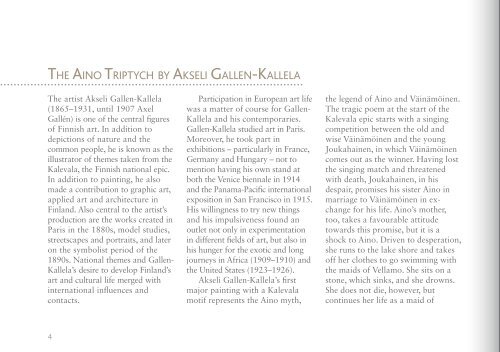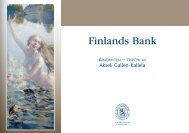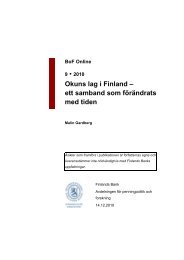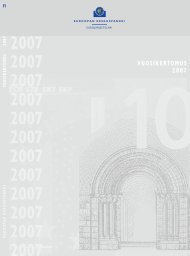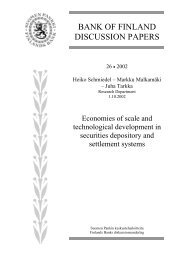Akseli Gallen-Kallela - Suomen Pankki
Akseli Gallen-Kallela - Suomen Pankki
Akseli Gallen-Kallela - Suomen Pankki
You also want an ePaper? Increase the reach of your titles
YUMPU automatically turns print PDFs into web optimized ePapers that Google loves.
The Aino Triptych by <strong>Akseli</strong> <strong>Gallen</strong>-<strong>Kallela</strong><br />
The artist <strong>Akseli</strong> <strong>Gallen</strong>-<strong>Kallela</strong><br />
(1865–1931, until 1907 Axel<br />
Gallén) is one of the central figures<br />
of Finnish art. In addition to<br />
depictions of nature and the<br />
common people, he is known as the<br />
illustrator of themes taken from the<br />
Kalevala, the Finnish national epic.<br />
In addition to painting, he also<br />
made a contribution to graphic art,<br />
applied art and architecture in<br />
Finland. Also central to the artist’s<br />
production are the works created in<br />
Paris in the 1880s, model studies,<br />
streetscapes and portraits, and later<br />
on the symbolist period of the<br />
1890s. National themes and <strong>Gallen</strong>-<br />
<strong>Kallela</strong>’s desire to develop Finland’s<br />
art and cultural life merged with<br />
international influences and<br />
contacts.<br />
Participation in European art life<br />
was a matter of course for <strong>Gallen</strong>-<br />
<strong>Kallela</strong> and his contemporaries.<br />
<strong>Gallen</strong>-<strong>Kallela</strong> studied art in Paris.<br />
Moreover, he took part in<br />
exhibitions – particularly in France,<br />
Germany and Hungary – not to<br />
mention having his own stand at<br />
both the Venice biennale in 1914<br />
and the Panama-Pacific international<br />
exposition in San Francisco in 1915.<br />
His willingness to try new things<br />
and his impulsiveness found an<br />
outlet not only in experimentation<br />
in different fields of art, but also in<br />
his hunger for the exotic and long<br />
journeys in Africa (1909–1910) and<br />
the United States (1923–1926).<br />
<strong>Akseli</strong> <strong>Gallen</strong>-<strong>Kallela</strong>’s first<br />
major painting with a Kalevala<br />
motif represents the Aino myth,<br />
the legend of Aino and Väinämöinen.<br />
The tragic poem at the start of the<br />
Kalevala epic starts with a singing<br />
competition between the old and<br />
wise Väinämöinen and the young<br />
Joukahainen, in which Väinämöinen<br />
comes out as the winner. Having lost<br />
the singing match and threatened<br />
with death, Joukahainen, in his<br />
despair, promises his sister Aino in<br />
marriage to Väinämöinen in exchange<br />
for his life. Aino’s mother,<br />
too, takes a favourable attitude<br />
towards this promise, but it is a<br />
shock to Aino. Driven to desperation,<br />
she runs to the lake shore and takes<br />
off her clothes to go swimming with<br />
the maids of Vellamo. She sits on a<br />
stone, which sinks, and she drowns.<br />
She does not die, however, but<br />
continues her life as a maid of<br />
4


